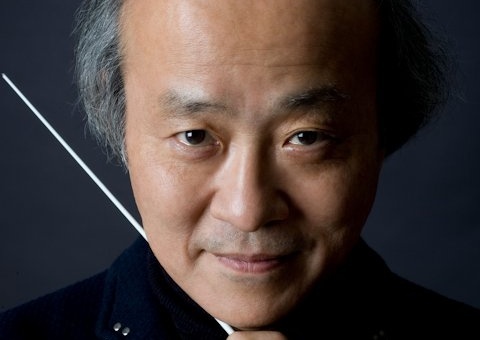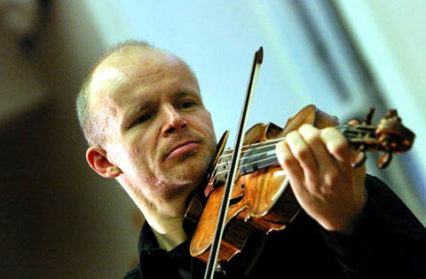Nigel Jarrett was at St David’s Hall in Cardiff to review a performance of Daphnis et Chloé by National Orchestra of Wales conducted by Tadaaki Otaka.
Rarely does a concert soloist encore with something refreshingly modern, even though 1951 as a year of composition might not be considered truly contemporary. Violinist Thomas Zehetmair chose the first movement of the Sonata for Solo Violin by German composer Bernd Alois Zimmermann to cap his exhilarating performance in Prokofiev’s Violin Concerto No.2. The concerto was the centrepiece in a programme crammed with striking effects, from Mozart emerging into the spotlight as an opera composer, to Ravel indulging fully his love of the antique and providing the BBC National Orchestra of Wales and its chorus with a further offering in its 2016-17 theme of storytelling in music, this time under conductor-laureate Tadaaki Otaka.
Few top-flight violinists have the acuity and the apparent spontaneity of Zehetmair, whose choice of the Zimmermann sonata’s ethereal opening as an addendum to a concerto with no flashy cadenza was inspired. After the Prokofiev’s final movement, a boisterously dissonant affair, it also seemed to inhabit a place to which Prokofiev might have been travelling, albeit a place of rest, although unpredictability is part of the second concerto’s attraction. In stressing that, Zehetmair always seemed to be leading the procession to the extent of hoping the orchestra was keeping line abreast. Playing from an aide-mémoire score, he scarcely turned to acknowledge what the others were doing, save for a few tacit acknowledgements in the conductor’s direction. Everything mostly worked, from the twists and turns of the opening movement to the rising sonorities of the second and the third’s devilish folk dance. This was in spite of appearances, which aurally had the soloist embedded but visually out on a limb and sometimes on the verge of momentarily losing contact. It sometimes felt as though Zehetmair, who has directed chamber orchestras as a violinist, was doing the same here. The orchestra did well to mask appearances with collaborative playing of its own.

In terms of method if not classical structure, there were connections to be made between the Prokofiev work and Mozart, whose overture to Idomeneo opened the concert in Otaka’s best snappy style. Despite its zest, it couldn’t match Mozart’s audacity in an opera which saw the composer emerge fully-formed as an exponent of music-theatre. If anticipation is a mark of foregoing promise, the quiet coda of this overture after an opening which the scholar Julian Rushton called ‘a suggestion of regal splendour under threat’ left us begging for the curtain to rise. Its boldness was boldly expressed.
Rise it did, but after the interval and on Ravel’s Daphnis et Chloé ballet music. The narrative of the ballet is ever obscured by the sumptuousness of the music, which on this occasion didn’t always arise with clarity and purpose, except in the obvious places where the static figures, as if on a Greek vase, leap into life. Like the previous offering in the storytelling trope on which the orchestra has embarked, Stravinsky’s The Rite Of Spring, there are places in the complete score where the listener begs to see the visual action being described. The stand-alone sections, however, which constitute the suites boiled down from the whole and to the abstract, were ravishingly painted. It’s common nowadays to insist on a greater variety of tempi and dynamics than historically hitherto, as was the case here. But Otaka was not to be hurried, and he allowed those sections which seem to emerge into view, such as the choral ‘interlude’ and the daybreak scene that opens the third part, to arise with not too much prompting.
Strangely in a hall renowned for the integrity of its acoustic, St. David’s tends to quiver when hit by the kind of uber-volumes reached in parts of this score. That’s no-one’s fault and there’d be little point in holding back to compensate. It did, however, result in more savage contrasts than a conductor such as, say, Pierre Monteux, would have thought appropriate. What Otaka did nonetheless was bring the ballet to life, and if we had to put up with a few moments of aural uncertainty while that was happening, it amounted to no great loss. The score’s culmination in the most rousing orgasm ever depicted in music was never likely to be toned down. Among the musicians selected by the conductor for special recognition were flautist Matthew Featherstone, piccolo player Eva Stewart, harpists Val Aldrich-Smith and Ceri Wynne Jones, Chris Stock’s percussion team, and horn player Tim Thorpe; all of them prominent among equals. The chorus’s artistic director, Adrian Partington, also shared the applause. It might have been for making sure we heard the variation of vowel sounds in the choir’s vocalese. We heard most of it which, for a hefty contingent behind a big orchestra – more front stalls seats taken out – was a feat worth mentioning.
Header photo of Thomas Zehetmair credit Keith Pattison
Daphnis et Chloé
St David’s Hall, Cardiff, 10 November 2016
BBC National Orchestra and Chorus of Wales.
Soloist: Thomas Zehetmair (violin)
Conductor: Tadaaki Otaka
Mozart: Idomeneo (overture)
Prokofiev: Violin Concerto No. 2 in G minor
Ravel: Daphnis et Chloé (choreographic symphony in three parts)



 Enjoyed this article? Support our writers directly by buying them a coffee and clicking this link.
Enjoyed this article? Support our writers directly by buying them a coffee and clicking this link.







